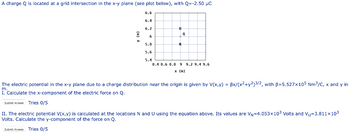Question

Transcribed Image Text:A charge Q is located at a grid intersection in the x-y plane (see plot below), with Q=-2.50 µC
6.6
6.4
6.2
6
5.8
5.6
€
5.4
8.4 8.6 8.8
-U
N
Q
9 9.2 9.4 9.6
x (m)
The electric potential in the x-y plane due to a charge distribution near the origin is given by V(x,y) = Bx/(x²+y²)3/2, with B=5.527x105 Nm³/C, x and y in
I. Calculate the x-component of the electric force on Q.
m.
Submit Answer Tries 0/5
II. The electric potential V(x,y) is calculated at the locations N and U using the equation above. Its values are VN-4.053×10³ Volts and V₁-3.811×10³
Volts. Calculate the y-component of the force on Q.
Submit Answer Tries 0/5
Expert Solution
This question has been solved!
Explore an expertly crafted, step-by-step solution for a thorough understanding of key concepts.
Step by stepSolved in 3 steps with 3 images

Knowledge Booster
Similar questions
- In the figure a plastic rod having a uniformly distributed charge Q = -27.2 pC has been bent into a circular arc of radius 1.82 cm and central angle 120°. With V = 0 at infinity, what is the electric potential in volts at P, the center of curvature of the rod? Number i Units + Qarrow_forwardA 2.00 nC charge is placed on the x-axis at x = -3.00 cm, another 2.00 nC charge is placed on the x-axis at x = 3.00 cm, and a third 2.00 nC charge is placed on the y-axis at y = 3.00 cm. What is the potential at the origin? %3D 2700 V 3600 V 5400 V O 1800 V O 108 Varrow_forwardA positive charge is evenly distributed on the surface of a metal sphere centered at the origin of the coordinate system. The positive charge produces an electric field that points outwardly in the radial direction. A positive test charge is fixed at a distance R₁ from the center of the coordinate system, far from the surface of the sphere. The electric potential at R₁ is 10V. The positive test charge is then allowed to move freely until it reaches a distance R₂=2R₁ from the center of the coordinate system. What is the electric potential (in Volts) of the test charge at its new resting point? 10arrow_forward
- The electric potential at points in an xy plane is given by V= (1.70 V/m²)x² -(3.00 V/m²)y2. What are (a) the magnitude of the electric field at the point (2.90 m, 1.60 m) and (b) the angle that the field there makes with the positive x direction. (a) Number i (b) Number i Units Unitsarrow_forwardConsider two separate systems with four charges of the same magnitude q = 16 µC arranged in the vertexes of a square of length h = 35 cm, see the picture below. Calculate the electric potential at the center of the square (points A and C) and at the middle of the bottom side of the square (points B and D). y y h h А. C. h В D b- The potential at point A, VA = 2320457.1x Units v The potential at point B, Vg = 2378380.8 Units V The potential at point C, Vc = 0 Units V The potential at point D, V, = -908380.8: Units v How much work is required to move a -12 µC charge from point A to point B? The work required, WAs =|-0.7349 X Units J How much work is required to move a -12 µC charge from point C to point D? The work required, Wc-o = 10.90 Units Jarrow_forwardA hollow metal sphere has a potential of +380 V with respect to ground (defined to be at V = 0) and has a charge of 4.4 x 10-⁹ C. Find the electric potential at the center of the sphere. Number i Units +arrow_forward
- A charge of uniform density (27 nC/m) is distributed along the x axis from the origin to the point x = 24.5 m. What is the electric potential (relative to zero at infinity) at a point, x = 76.5 m, on the x axis?arrow_forwardA charge of uniform density (51 nC/m) is distributed along the x axis from the origin to the point x = 10.2 m. What is the electric potential (relative to zero at infinity) at a point, x = 77.1 m, on the x axis?arrow_forwardA charge Q = 2.00 10-8 C is surrounded by an equipotential surface with a surface area of 1.23 m2. What is the electric potential at this surface? Varrow_forward
- A Uniform electric field of magnitude 300 N/m is directed parallel to the +X axis. The electric potential at the origin is equal to 150 volts. Determine the electric potential: on x-axis at x = 15 cm and x = -15 cm on y-axis at Y = 6 cm at point (6 cm, 4.5 cm)arrow_forwardA charge of uniform density (56 nC/m) is distributed along the x axis from the origin to the point x = 15.1 m. What is the electric potential (relative to zero at infinity) at a point, x = 70.8 m, on the x axis?arrow_forwardThree point charges are on three corners of a rectangle. The A width of the rectangle is x = 70.1 cm and the length is Q + y = = 70.1 cm. Find the potential at the other corner (A) if Q1 = 21.4 µC, Q2 -38.6 μC and Q 57.3 µC. y potential: V Q2 + ) Q3 K x –arrow_forward
arrow_back_ios
SEE MORE QUESTIONS
arrow_forward_ios